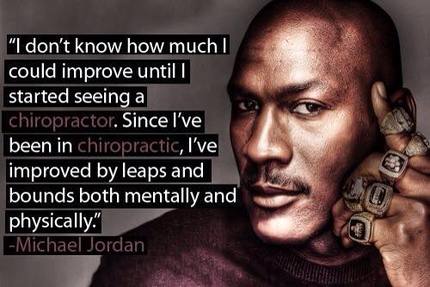6 Health Benefits with Chiropractic Care
10/3/2014
By: Albert Huang, DC  What's the first thing that comes to mind when you hear the word chiropractic? Did you instantly think back or neck pain? Adjustment? Spinal health? Most people would associate going to a chiropractor with the aforementioned. Certainly, chiropractors perform adjustments and yes, chiropractic is effective in reducing back pain but is there anything more that they can help you with above and beyond spinal health? Let's explore the 6 Biggest Benefits of Chiropractic Care: 1) Stress Relief Studies show that chronic stress is related to disease onset and negative health effects. Stress is a sympathetic reaction that triggers a fight or flight response in the body. The inability to cope with stress overtime results in muscle tightness, fatigue, and nerve irritation. Chiropractor's can help lessen stress through body work, breathing techniques, and exercise prescription. Spinal adjustments can also help the body return to a more balanced, relaxed state by improving neurological function and adaptability. 2) Pain Management Chiropractic is a safe, natural, and drug-free approach to pain management. Research has shown this treatment option to be effective in reducing headaches, back, and neck pain. The goal with therapy is to address the root cause of the pain and improve function. 3) Healthier Brain function & Mind-Body connection Your brain is the master controller and orchestrates everything that happens in your body. Your attention, cognitive processing, learning, motor-control, breathing, heart rate, blood pressure, and digestion are all controlled by your brain and nerve system. Spinal misalignments may cause nerve interference and lead to mind-body dissociation. The intent of chiropractic treatment is to alleviate aberrant forces and optimize communication between the nervous system to the rest of your body. When your brain and nerve system function well, your body functions well. 4) Better Posture Chances are that you spend at least half of your day sitting. Since, humans weren't built to sit for extended periods, the majority of us experience postural changes and strains. Poor posture is related to fatigue, decreased productivity, back and neck pain. Your chiropractor is trained to provide exercise recommendations, stretches, ergonomic and lifestyle counselling, physical therapy and rehabilitative procedures to improve your musculoskeletal system and posture. 5) Improved Sex, Libido, & Reproduction Sexual function once again stems from the ability of the nervous system and endocrine to perform well. Proper communication by nerve signalling between your sex organs, hormonal center, and musculoskeletal system are important for libido health and sexual function. So how are the endocrine and nervous system linked? A part of the brain called the hypothalamus connects these two essential systems. The hypothalamus regulates basic needs such as sleep, hunger, thirst, stress response, and sex. This is why people under chiropractic care often report improvement in things like depression, anxiety, sleep patterns, energy levels, sexual performance, and reproductive function. 6) Optimize Body Performance and Overall Health The body is a self-regulating and self-healing organism that knows how to repair and preserve itself. The body heals itself through cellular processes that are directly controlled by the nervous system. It will do this as long as there is no interference in the nerve flow to the tissues. Some of the most impacting areas of chiropractic medicine include improved circulation, relaxation. better performance, enhanced mobility, and faster recovery time. Your chiropractic doctor will thoroughly assess your overall health and if they discover underlying health problems or conditions that are outside of their area of expertise, they will refer you to a medical professional who can help you. Book your appointment today and find out first hand what other benefits chiropractic can offer you!
109 Comments
By: Erin Ziprick, RMT  A few years ago I was fortunate enough to travel down to Mexico to participate in a massage course. Not only did I get to enjoy the sandy beaches and beautiful oceans for two weeks, I was also in the presence of amazing Massage Therapists who inspire me with new treatment techniques. The instructor truly has a unique approach to massage therapy as it was he who introduced me to Visceral Manipulation. For those of you who aren't familiar with Visceral Manipulation, I will do my best to explain more about it. Visceral Manipulation (VM) is a manual therapy that focuses on internal organs (visceral), their environment and potential influences on structural dysfunctions. It evaluates and treats motions in relation to organs, membranes, fascia, and ligaments. With applying a gentle manipulation and specific hand placement of manual forces, it helps to encourage normal movement of the connective tissue and viscera. (Barral, J) Visceral Manipulation was developed from a French osteopath and Physical Therapist named Jean-Pierre Barral in 1971. VM was introduced to the United States back in 1985 and since then he has trained a team of International Teachers who continue to teach around the world. Jean-Pierre is continuing research and development in this area as well as maintaining a full-time practice. (Barral, J) Areas of the body affected from dysfunction of the viscera: * Musculoskeletal System * Vascular System * Nervous System * Urogential System * Respiratory System * Digestive System * Lymphatic System How can Visceral Manipulation help you? If you are unsure if Visceral Manipulation is right for you, feel free to contact the clinic for more information regarding the treatment. The following are common scenarios where VM can help you;* Motor Vehicle Accident related injuries (ie. Whiplash, seat belt injuries) * Digestive Disorders (ie. Bloating, constipation, nausea, GERD) * Women and Men’s Health Issues * Musculoskeletal Disorders (ie. Headaches/Migraines, chronic spinal dysfunction) * Pain related to post-operative scar tissue * Poor posture * Sport Injuries Using the technique correctly can help relieve pain, decrease dysfunction and improve functioning of the entire body. What to expect with treatment: A VM treatment would be incorporated into your regular massage treatment. Depending on the area of concern, there would be undraping of the abdomen with a towel to cover your chest. Usually the treatments are over skin or sheets but the comfort of the client comes first and can always be adapted to client’s comfort level. Communication is key between the therapist and client. The movements are gentle and subtle so having that open communication and trust is important. Who can practice VM in your community? A wide variety of health care practitioners can perform VM including osteopathic, chiropractics, physicians, naturopathic doctors, physical therapists, occupational therapists, massage therapists and other licensed body workers. In the 4 years that I have been practicing Visceral Manipulation, I have seen changes in people who would normally not see any differences. For example, a few years back, a middle aged women with chronic lower back pain came into my office. She was frustrated with the constant pain of moving around and everyday life. During the massage she revealed to me that she had a medical history of 3 C-sections. I then left 15-20 minutes before the end of her massage to do some direct treatment to her surgical scars and abdomen. Believe it or not, but she felt immediate change and releases that all referred into her lower back. It was a humbling experience that I was able to give her that relief. Depending on the situation and medical history, everyone may experience different side effects and benefits. The results do vary but this was one women’s perspective and I was happy to be able to help her the best I could. If you were still unsure that this form of therapy or you or had more questions, please feel free to book an appointment and we can do an assessment or send me an email. References http://www.barralinstitute.com/about/vm.php Barral, Jean-Pierre, Pierre Mercier. Visceral Manipulation. Eastland Press, 2005. Print Understanding Low Back Pain
1/27/2014
Dr. Mike Evans illustrates the basics of low back pain through narrated whiteboard drawings. Visual representations allow us to better understand our back pain and see what is going on within our bodies. Don't let back pain stop you from achieving your daily goals. Be proactive, stay moving, and ask how we can improve your back health!
 Chances are that you or someone you know has been affected by back pain at some point in your life. The statistics are stacked against you and I, as low back pain affects at least 80% of us some time in our lives, perhaps 20-30% at any given time. Back pain can be debilitating and can affect each person differently. Some people only experience discomfort for a few days while others suffer from it for months or even years. Acute back pain can last anywhere from days to weeks and is usually mechanical in nature. Symptoms may range from muscle ache to shooting or stabbing pain, limited flexibility and/or range of motion, or an inability to maintain proper posture. The good news is that these acute episodes generally respond well to conservative therapies and have the ability to resolve relatively quickly. Albeit some acute pain syndromes can progress to become more serious if left untreated. Chronic back pain is classified as pain persisting for three months or greater. It is generally more complicated and multi-faceted in nature. In some instances, pain may travel or radiate to another part of the body causing distal numbness, tingling, and/ or weakness. Chronic pain syndromes can involve physical, chemical, and/ or psychological components which can require more therapy time and more in-depth treatment protocols. At any rate, back pain is debilitating and can be a lingering nuisance in our daily routines. The key to successful treatment and recovery starts with the ability to determine the primary reason(s) causing the problem. A symptom such as pain may seem urgent but pain is merely a residual effect to a primary dysfunction. Pain fibers only make up less than ten percent of body's overall nerve fibers. This means that there can be a dysfunction, pathological problem, and/or biomechanical imbalance occurring somewhere in the body without pain being present. Therefore, basing wellbeing on pain-symptoms alone does not effectively measure one's overall health. Getting a detailed examination by a qualified health practitioner will help determine the root cause of pain generators which accordingly can help better one's prognosis. Let's explore the viable treatment options for low back pain and the efficacy of each. Let us first start with a visit to our primary care physician. Typically, after a short-lived appointment, the medical doctor may suggest some rest and avoidance of strenuous activity. He or she may opt to write out a prescription for a few pain killers and muscle relaxants for your back pain. Having trust in our physician, we take the medications sometimes without questioning: "Is this natural? Are pharmaceutical drugs the best solution to a small case of back pain?" |
AuthorPosts inspired by the team at Platinum Health & Wellness. Archives
June 2025
Categories
All
|
|
 RSS Feed
RSS Feed